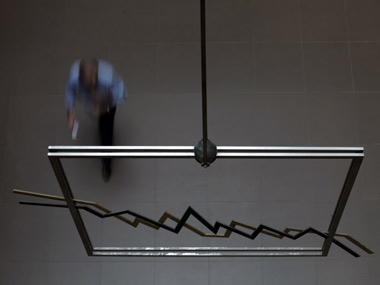In late May, when I suggested that global equity markets were in for a rough ride , many readers posted comments vehemently disagreeing with me - and made known their opinion in the freewheeling, irreverent way that characterises commentary on the internet. It struck me then, as I noted here , that investors were perhaps overly insensitive to the global macro risks that hung over equity markets.
The sharp sell-off of recent days, leading up to today’s bloodbath, is only the manifestation of those global macro risks seeping through stock markets. These risks just didn’t appear out of nowhere, they were always around. It’s just that investors making short-term trades tended to discount the big picture - and are now shell-shocked when the market catches up with reality.
What are these risks? None of them specifically relate to India, but given the Indian market’s excessive exposure to foreign institutional investors, they aren’t immune to everything that goes on around the world.
There are three major risks, and if you think of the global economy as an aircraft, three of its engines are sputtering, heightening the risk of a crash landing.
[caption id=“attachment_55192” align=“alignleft” width=“380” caption=“Going by the experience of the two earlier rounds of quantative easing, its long-term negative consequences could undo whatever its short-term benefits it brings. AFP Photo”]
 [/caption]
[/caption]
First, the US economy , the world’s largest, is weakening, and some analysts reckon is at risk of a double dip recession . The drama around the debt ceiling debate that culminated in the Congressional deal earlier this week has not solved the larger problem of US debt obligations and its crushing deficit. And the political gridlock that has Washington in its grip has ensured that a reasonable solution to it will not be achieved in the near term.
Impact Shorts
More ShortsMohamed A El-Erian, CEO of investment management firm PIMCO, notes that “it is now undeniable that the US economy is weakening across the board.” And although US corporate earnings have held up thus far, the outlook is for them to turn softer. And with US unemployment still edging close to 10 percent (the latest jobs numbers will be out later today), the mood is decidedly grim.
The US Federal Reserve Board meets next week, and one of the remedies it could consider is the introduction of another round of Quantitative Easing, the easy money policy of which the US has seen two rounds earlier. But the problem is that the two earlier rounds only ended up inflating equity asset values, without doing anything to restore the health of the underlying economy. There’s no certainty that a third round will do it either, but policymakers in the US have run out of options, and are stuck with firing blank bullets.
In hindsight, the relief rally we saw earlier this week in global equity markets was entirely a case of markets missing the woods for the trees. The markets were relieved to have had a Congressional deal - even a bad deal - and are only now coming to terms with the fact that it doesn’t solve anything, and may have actually compounded the debt problem.
The second risk is Europe, where too - as was noted here - the bailout hasn’t addressed underlying debt problems . Since then, the contagion has spread from peripheral states to larger Eurozone states, including Spain and Italy.There too, it was a failure of policymakers to act decisively that allowed the contagion to spread, and today even the continent’s banking system stands infected.
Halfway across the world, the third engine of the global economy - China - too is sputtering. And although its state-directed investment could still prop up GDP growth at levels that suggest that China will “lift up the world”, that growth-on-steroids is also at risk from a mounting local government debt problem that is much bigger than the government acknowledges - and a whole lot worse than investors are budgeting for.
Where does that leave India? As has become evident in recent days, India too faces the prospect of a slowdown of its economy owing to untamed inflation. And with the government practically conceding defeat in the battle against inflation (going by Finance Minister Pranab Mukherjee’s comments in Parliament yesterday), the risk to growth is on the downside.
There’s still the fleeting hope that a global economic slowdown - or the feared recession in the US - could cause inflationary pressures to ease somewhat, which should benefit India. But against that must be weighed the effect of a third round of Quantitative Easing in the US. Going by the experience of the two earlier rounds, its long-term negative consequences could undo whatever its short-term benefits it brings.
All these global issues don’t lend them to easy solutions, and so it’s unlikely that the problems underlying the markets will be resolved anytime soon. Until that resolution comes about over the medium term, global markets will continue to remain choppy, and drag down Indian markets with them. It’s folly to read short-term minor recoveries as signs of a fundamental turnaround in sentiments. It never gives any joy for a Pollyanna to be proved right and be able to say ‘I told you so’.
Venky Vembu attained his first Fifteen Minutes of Fame in 1984, on the threshold of his career, when paparazzi pictures of him with Maneka Gandhi were splashed in the world media under the mischievous tag ‘International Affairs’. But that’s a story he’s saving up for his memoirs… Over 25 years, Venky worked in The Indian Express, Frontline newsmagazine, Outlook Money and DNA, before joining FirstPost ahead of its launch. Additionally, he has been published, at various times, in, among other publications, The Times of India, Hindustan Times, Outlook, and Outlook Traveller.
)